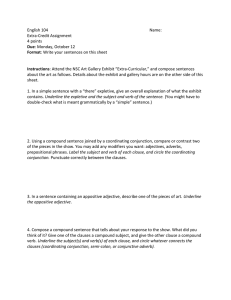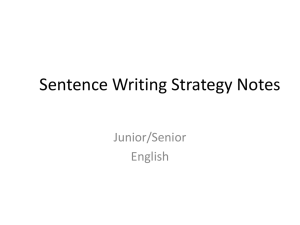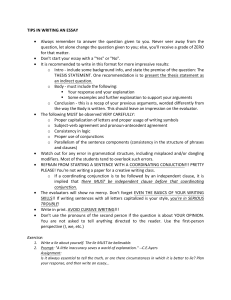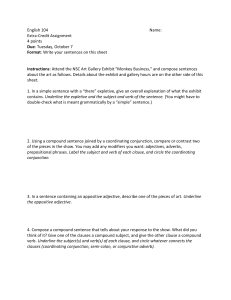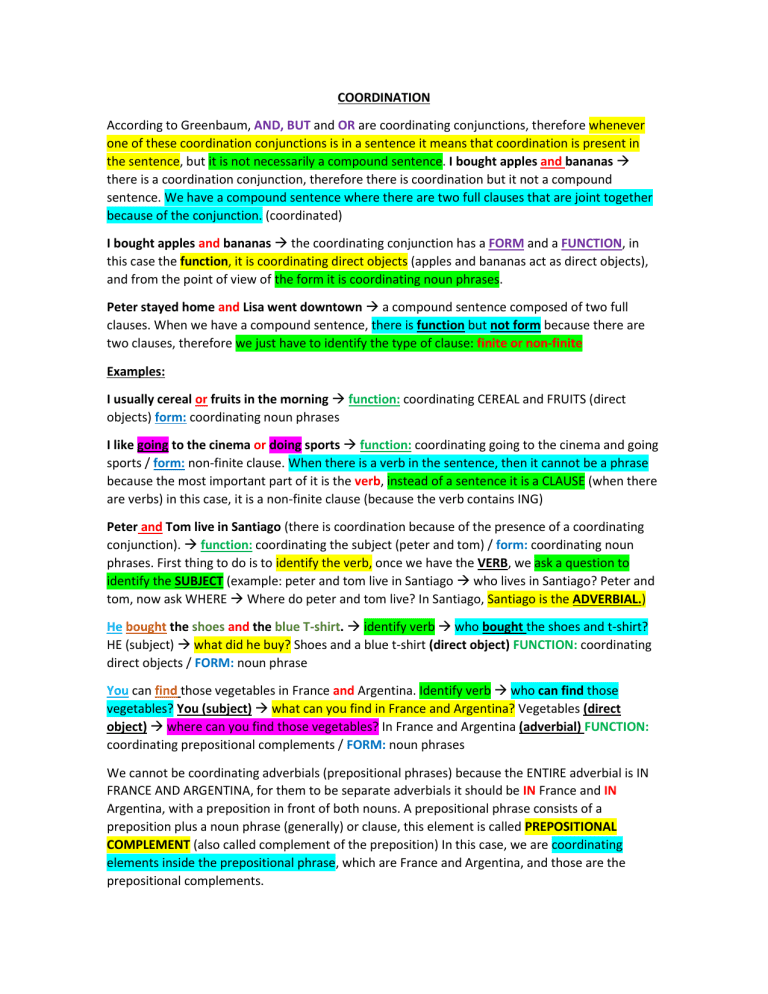
COORDINATION According to Greenbaum, AND, BUT and OR are coordinating conjunctions, therefore whenever one of these coordination conjunctions is in a sentence it means that coordination is present in the sentence, but it is not necessarily a compound sentence. I bought apples and bananas there is a coordination conjunction, therefore there is coordination but it not a compound sentence. We have a compound sentence where there are two full clauses that are joint together because of the conjunction. (coordinated) I bought apples and bananas the coordinating conjunction has a FORM and a FUNCTION, in this case the function, it is coordinating direct objects (apples and bananas act as direct objects), and from the point of view of the form it is coordinating noun phrases. Peter stayed home and Lisa went downtown a compound sentence composed of two full clauses. When we have a compound sentence, there is function but not form because there are two clauses, therefore we just have to identify the type of clause: finite or non-finite Examples: I usually cereal or fruits in the morning function: coordinating CEREAL and FRUITS (direct objects) form: coordinating noun phrases I like going to the cinema or doing sports function: coordinating going to the cinema and going sports / form: non-finite clause. When there is a verb in the sentence, then it cannot be a phrase because the most important part of it is the verb, instead of a sentence it is a CLAUSE (when there are verbs) in this case, it is a non-finite clause (because the verb contains ING) Peter and Tom live in Santiago (there is coordination because of the presence of a coordinating conjunction). function: coordinating the subject (peter and tom) / form: coordinating noun phrases. First thing to do is to identify the verb, once we have the VERB, we ask a question to identify the SUBJECT (example: peter and tom live in Santiago who lives in Santiago? Peter and tom, now ask WHERE Where do peter and tom live? In Santiago, Santiago is the ADVERBIAL.) He bought the shoes and the blue T-shirt. identify verb who bought the shoes and t-shirt? HE (subject) what did he buy? Shoes and a blue t-shirt (direct object) FUNCTION: coordinating direct objects / FORM: noun phrase You can find those vegetables in France and Argentina. Identify verb who can find those vegetables? You (subject) what can you find in France and Argentina? Vegetables (direct object) where can you find those vegetables? In France and Argentina (adverbial) FUNCTION: coordinating prepositional complements / FORM: noun phrases We cannot be coordinating adverbials (prepositional phrases) because the ENTIRE adverbial is IN FRANCE AND ARGENTINA, for them to be separate adverbials it should be IN France and IN Argentina, with a preposition in front of both nouns. A prepositional phrase consists of a preposition plus a noun phrase (generally) or clause, this element is called PREPOSITIONAL COMPLEMENT (also called complement of the preposition) In this case, we are coordinating elements inside the prepositional phrase, which are France and Argentina, and those are the prepositional complements. He is happy but worried. Identify verb who is happy but worried? He what is he like? Happy but worried (subject complement) FUNCTION: coordinating subject complement / FORM: adjective phrases I consider him handsome and nice. Identify verb I (subject) him (object) handsome and nice (object complement) FUNCTION: object complement / FORM: adjective phrase He sings softly and beautifully. Identify verb who sings softly? He how does he sing? Softly and beautifully? FUNCTION: coordinating adverbials (as the adverbs are complementing the verb and indicating HOW something is done, then they are ADVERBIALS) / FORM: adverb phrases She has a big and ugly house. Identify verb who has a big and ugly house? She (subject) what does she have? a big and ugly house (direct object) what is her house like? Big and ugly (object complement) // FUNCTION: coordinating pre-modifiers (In this case, big and ugly are part of the object therefore they cannot act as object complements. They are describing the word HOUSE, which is a noun, so they are acting as pre-modifiers of the word house). / FORM: adjective phrases They play in the house and in the garden. Identify verb who plays in the house? They (subject) where do the play? In the house and garden (adverbial) FUNCTION: coordinating adverbials / FORM: coordinating prepositional phrases (there are two prepositional phrases: IN the house and IN the garden) Syndetic, asyndetic and polysyndetic coordination: In syndetic coordination the units are linked by a coordinating conjunction that is written in the sentence, such as and, or, but: slowly and stealthily, he crept towards him. In asyndetic coordination, coordinators are not present, but they could be present or implied to be there: slowly, stealthily, he crept towards his victim. When more than two units are linked by and/or, it is usual to insert the coordinator once only between the last two units: the wind roared, the lightning flashed, and the clouds raced across the sky. In polysyndetic coordination, the coordinator is repeated between each pair of units: the wind roared, and the lightning flashed, and the clouds races across the sky. SYNTACTIC FEATURES OF COORDINATORS Clause coordinators are restricted to be used in the initial position of the second clause, used at the beginning of the second clause: John plays the guitar, and his sister plays the piano. (We are coordinating two full clauses; there it is a compound sentence.) Coordinated clauses are sequentially fixed, this means that there is a certain sequence that we can follow: He opened the door and Mary went in it cannot be the other way around because in order to enter, we need to open the door. Coordinators are not preceded by a conjunction, this means that we can never have two conjunctions together: He tried hard, but he failed just one coordinator is present, we cannot say he tried hard and but he failed. Coordinators can link clause constituents, by constituents we refer to predicate and predication. Example: I may see you tomorrow or may phone late in the day. in here we are not coordinating full clauses because the second part is not a full clause because it doesn’t have a subject (it is elided), meanwhile the first one is a full clause. In order to coordinate two elements, these must belong to the same type, therefore we cannot coordinate a full clause with a nonclause. Instead, we are coordinating PREDICATES, because everything that goes after the subject corresponds to the predicate (inside which are all the other constituents: verb, objects, adverbials, etc.) Peter can take you downtown and go with you to the store. in the first part there is an auxiliary and in the second part of this sentence, we are eliding both the subject and the auxiliary verb CAN, this is called PREDICATION because we leave out the auxiliary. This sentence would be predicate if it were: peter can take you downtown and can go with you to the store. Coordinators can link subordinate clauses (the words BECAUSE and IF immediately indicate subordination): He asked for permission because he was tired and because he wanted to go to the doctor. / I need to know if you just want to visit or if you want to go out with her. Coordination of clauses or lesser constituents, this refers to when we coordinate elements of the sentence that are smaller than PREDICATE and PREDICATOR (these two are parts of the clause constituents) such as subject, objects, adverbials, complements, subject complement, pre and post modifiers, among others. Example: the weather will be cold and cloudy. in terms of function, we are coordinating subject complements, which is a lesser constituent. / The warm but windy weather will continue for several more days. coordinating adjective phrases that act as premodifiers of the noun WEATHER. Coordinators can link more than two clauses: the battery may be disconnected; the connections may be loose, or the bulb may be faulty. USES OF COORDINATOS / SEMANTICS (meaning) AND The event in the second clause if chronologically sequent to that in the first clause, there is a certain sequence that is determined by the coordinator: they washed the dishes and dried them. function: coordinating predicates because the subject is elided in the second part. The event in the second clause if a consequence or result of the event in the first one: I heard the doorbell and opened the door the fact that I opened the door is a consequence of the first action. FUNTION: coordinating predicates / FORM: verb phrases The second clause introduces a contrast (opposite ideas): Peter is short, and Tom is tall. The first clause has concessive force. We refer to a concessive force when an action has an expected result, but it is not fulfilled because the opposite thing happens: She tried hard, and she failed. the expected outcome of ‘’she tried hard’’ is for her to succeed, but she actually failed, which is the concessive force. The first clause is a condition of the second one: for the second to happen, the first one has to happen first. Example: Tell me her address and I’ll visit her. FUNCTION: coordinating full clauses (imperative sentences) / Give me money and I’ll do the shopping. The second clause makes a point similar to the first one. Example: John plays the guitar, and his sister plays the piano. / A trade agreement should be no problem and a cultural exchange could be easily arranged. The second clause is pure addition of information to the first one: They did not like it and did not say it. FUNCTION: coordinating predicates The second clause add an appended comment on, or explanation of the first one, this means that we add a comment at the end. Example: They dislike John and that is not surprising. coordinating two full clauses THE USES OF ‘’OR’’ Exclusive: choosing one or the other option: do you want tea or coffee? Inclusive: include more alternatives: do you want tea, coffee or both? The alternative expressed by ‘’or’’ may also be a restatement or a corrective to what is said the first conjoin (any of the clauses that are part of the sentence) when in the second part we paraphrase or express in a different way what is said in the first part. Example: they are enjoying themselves or they appear to be enjoying themselves (paraphrasing) It may imply a negative condition, implying that you must do something or if you don’t, the result is going to be negative switch on the radio or you’ll miss the bus. / Don’t be too long or you’ll be late. THE USES OF ‘’BUT’’ It expresses a contrast The second clause expresses in positive terms what the negation in the first clause conveys: Jane did not waste time before the exam but studied hard every evening. / I am not objecting to his morals, but to his manners. CORRELATIVES: either…or / both…and / neither…nor They are made of an endorsing item (either, both, neither) and a coordinator (or, and, nor) ‘’Either… or’’ emphasizes the exclusive meaning of ‘’or’’ ‘’both…and’’ emphasize the additive meaning of ‘’and’’ and the segregatory meaning. Example: Both David and Helen got divorced The segregatory meaning implies that David and Helen god divorced separately, not from each other. They cannot link full clauses. NOR and NEITHER: they are generally used together, but there are some exceptions. For example, when followed by subject-operator inversion, any of the two elements can be used without being a correlative pair. Example: All the students were obviously very miserable, nor were the teachers satisfied with the conditions at school. / He did not receive any assistance from the authorities, neither did he believe. NOT (ONLY)… BUT: not Henry, but his wife came to visit us. / He did not come to help, but to bother us. / They not only broke into his office but tore up his manuscripts.
